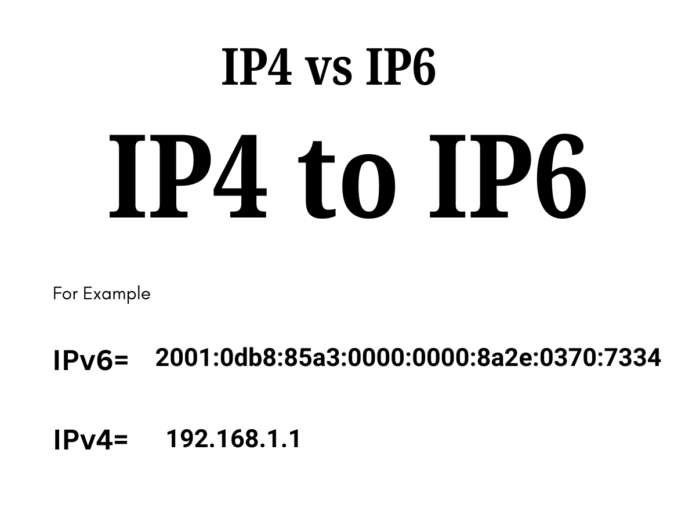IP is the backbone of the internet, allowing devices to communicate. The two main versions, IPv4 and IPv6, connect devices globally. IPv6 was developed to overcome IPv4’s limitations and support more connected devices.
IPv4: The Veteran Protocol
IPv4 (short mostly for Internet Protocol version 4) was a protocol of the 1980s that became a basis for the whole Internet. This scheme takes a 32-bit address, which is almost 4.3 billion countable and with only 4.3 billion unique items. For example, an IPv4 address might look like 192.168.1.1.
Key Features of IPv4:
- Address Format: IPv4 addresses are numeric decimal representations, comprising four octets separated by a dot (for example, 192.168.0.1).
- Address Space: IPv4 can potentially issue around 4.3 billion addresses with the use of a bearing of 32 bits. The impression of massive capacity in those days was however eventually revealed to be insufficient for the ever-increasing number of devices connected to the internet.
- Subnetting: IPv4 allows the use of subnetting, which is a technique for splitting a larger network into smaller, more easily administrable subnetworks.
- NAT (Network Address Translation): To address the problem of limited IPv4 addresses, NAT enables several devices in a local net to utilize just one public IP address.
Practical Example:
Imagine a tiny workplace having 10 computers. They are all linked to the internet with the help of one router. The way NAT works, the router gives a unique private IP address (e.g., 192.168.1.2, 192.168.1.3, etc.) to each computer while sharing a public IP address for internet communication. It thus helps conserve the scarce IPv4 address space.
IPv6: The Next Generation
IPv6, the successor to IPv4, was designed to solve the problem of limited address space. With a 128-bit address format, it provides a virtually unlimited number of unique addresses, exemplified by 2001:0db8:85a3:0000:0000:8a2e:0370:7334.
Key Features of IPv6:
- Address Format: IPv6 addresses are written in hexadecimal format, divided into eight groups separated by colons (e.g., 2001:0db8:85a3:0000:0000:8a2e:0370:7334).
- Address Space: IPv6 with 128 bits can give an endless volume of logical addresses which will be sufficient for the large number of devices to be connected in the next few decades.
- Simplified Header: The structure of the header in IPv6 is simpler than in IPv4. Thus, the routing improves and the performance becomes better.
- Auto-configuration: IPv6 accordingly gives support for stateless address auto-configuration (SLAAC) which provides that devices connect to an IPv6 network and configure themselves automatically.
- Built-in Security: IPv6 sets out to be secure and privacy-oriented by including IPsec, which is mandatory for encryption and authentication.
Practical Example:
Consider a smart home with dozens of devices, including lights, thermostats, and security cameras. Each device can have its own unique IPv6 address, allowing for direct communication and remote management without the need for NAT.
Key Differences Between IPv4 and IPv6
- Address Length:
- IPv4: 32 bits
- IPv6: 128 bits
- Address Format:
- IPv4: Decimal, separated by periods (e.g., 192.168.1.1)
- IPv6: Hexadecimal, separated by colons (e.g., 2001:0db8:85a3:0000:0000:8a2e:0370:7334)
- Address Space:
- IPv4: Approximately 4.3 billion addresses
- IPv6: Approximately 340 undecillion addresses
- Header Complexity:
- IPv4: More complex with multiple fields
- IPv6: Simplified header for better performance
- Configuration:
- IPv4: Manual or DHCP (Dynamic Host Configuration Protocol)
- IPv6: Auto-configuration (SLAAC) and DHCPv6
- Security:
- IPv4: Security is optional and implemented through additional protocols
- IPv6: Built-in IPsec support for encryption and authentication
Transitioning from IPv4 to IPv6
The move from IPv4 to IPv6 is a slow one since there are so many devices and networks that are still using IPv4.Dual stack implementation where devices run both IPv4 and IPv6 is a widely adopted method to ensure that compatibility is maintained during the transition.
Visual Aids
IPv4 Header Structure:
0 1 2 3
0 1 2 3 4 5 6 7 8 9 0 1 2 3 4 5 6 7 8 9 0 1 2 3 4 5 6 7 8 9 0 1
+-+-+-+-+-+-+-+-+-+-+-+-+-+-+-+-+-+-+-+-+-+-+-+-+-+-+-+-+-+-+-+-+
|Version| IHL |Type of Service| Total Length |
+-+-+-+-+-+-+-+-+-+-+-+-+-+-+-+-+-+-+-+-+-+-+-+-+-+-+-+-+-+-+-+-+
| Identification |Flags| Fragment Offset |
+-+-+-+-+-+-+-+-+-+-+-+-+-+-+-+-+-+-+-+-+-+-+-+-+-+-+-+-+-+-+-+-+
| Time to Live | Protocol | Header Checksum |
+-+-+-+-+-+-+-+-+-+-+-+-+-+-+-+-+-+-+-+-+-+-+-+-+-+-+-+-+-+-+-+-+
| Source Address |
+-+-+-+-+-+-+-+-+-+-+-+-+-+-+-+-+-+-+-+-+-+-+-+-+-+-+-+-+-+-+-+-+
| Destination Address |
+-+-+-+-+-+-+-+-+-+-+-+-+-+-+-+-+-+-+-+-+-+-+-+-+-+-+-+-+-+-+-+-+
| Options | Padding |
+-+-+-+-+-+-+-+-+-+-+-+-+-+-+-+-+-+-+-+-+-+-+-+-+-+-+-+-+-+-+-+-+
IPv6 Header Structure:
0 1 2 3
0 1 2 3 4 5 6 7 8 9 0 1 2 3 4 5 6 7 8 9 0 1 2 3 4 5 6 7 8 9 0 1
+-+-+-+-+-+-+-+-+-+-+-+-+-+-+-+-+-+-+-+-+-+-+-+-+-+-+-+-+-+-+-+-+
|Version| Traffic Class | Flow Label |
+-+-+-+-+-+-+-+-+-+-+-+-+-+-+-+-+-+-+-+-+-+-+-+-+-+-+-+-+-+-+-+-+
| Payload Length | Next Header | Hop Limit |
+-+-+-+-+-+-+-+-+-+-+-+-+-+-+-+-+-+-+-+-+-+-+-+-+-+-+-+-+-+-+-+-+
| |
| Source Address |
| |
| |
| |
+-+-+-+-+-+-+-+-+-+-+-+-+-+-+-+-+-+-+-+-+-+-+-+-+-+-+-+-+-+-+-+-+
| |
| Destination Address |
| |
| |
| |
+-+-+-+-+-+-+-+-+-+-+-+-+-+-+-+-+-+-+-+-+-+-+-+-+-+-+-+-+-+-+-+-+
Conclusion
IPv4 has been powering the internet for years, but its limited address space has pushed us towards IPv6. With its immense address capacity and superior performance and security, IPv6 is ready to drive the internet’s growth forward. Yet, the shift won’t happen overnight, so expect both IPv4 and IPv6 to share the stage for a while longer.


